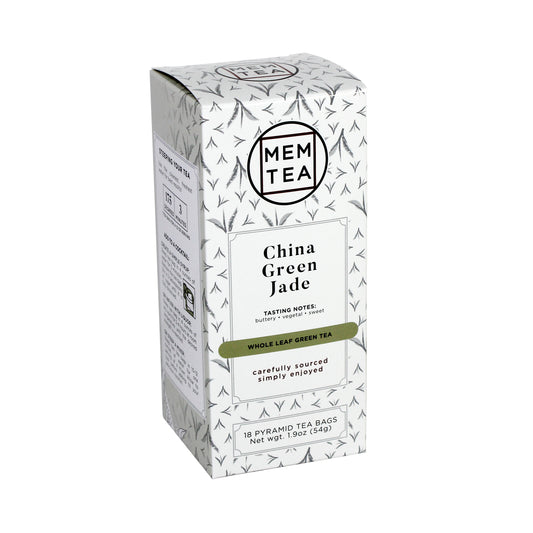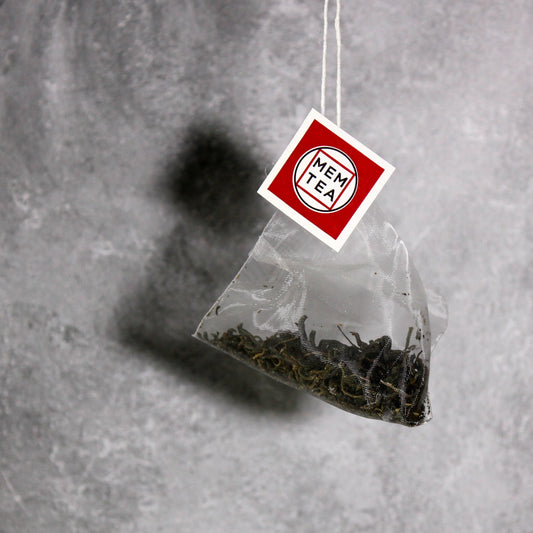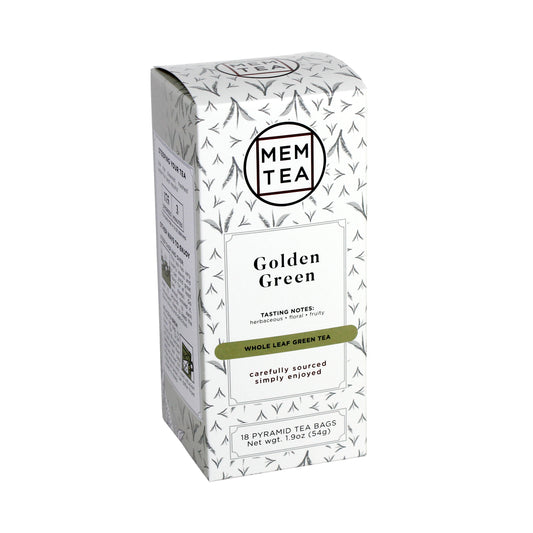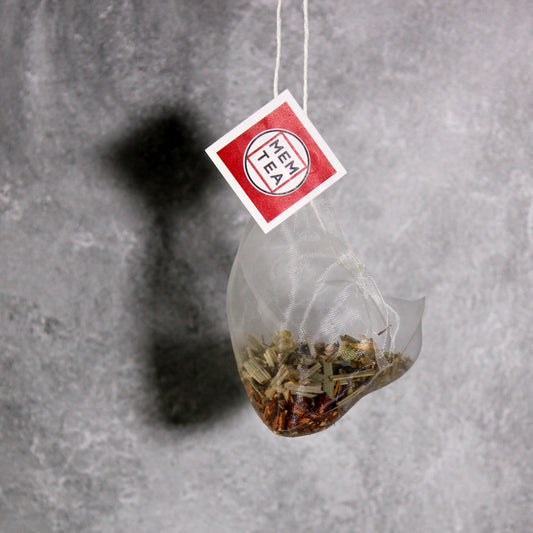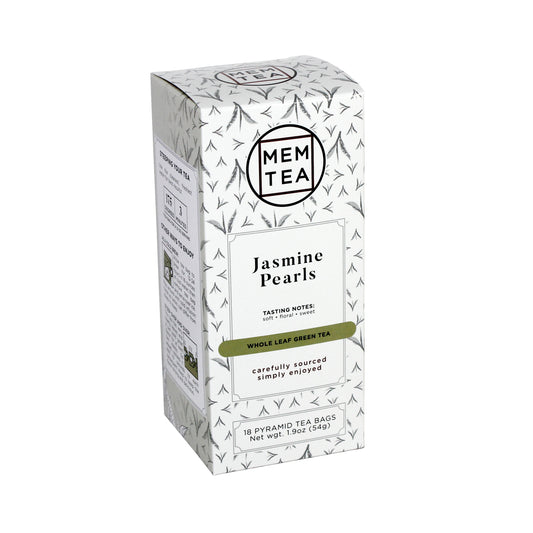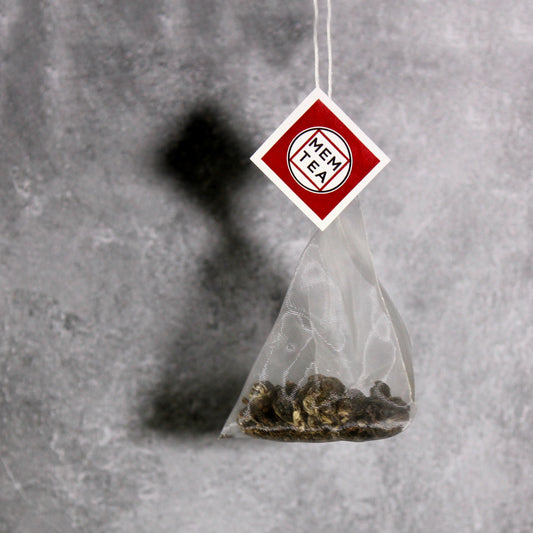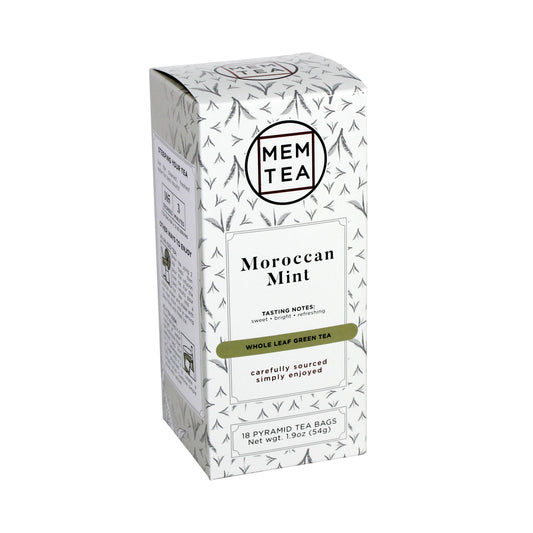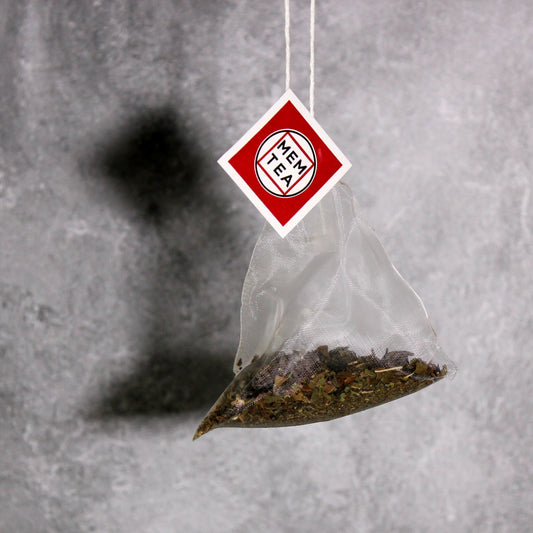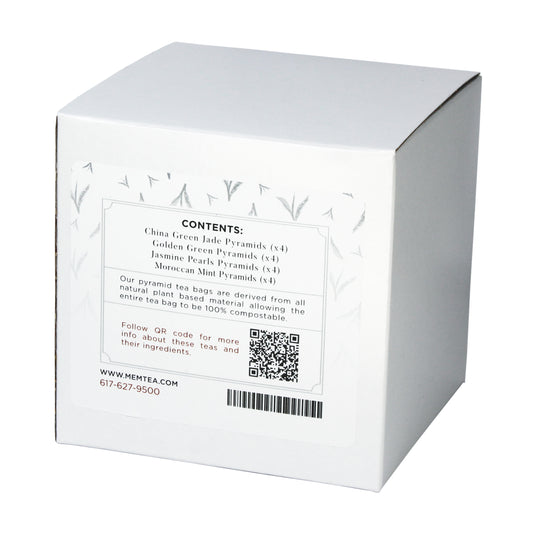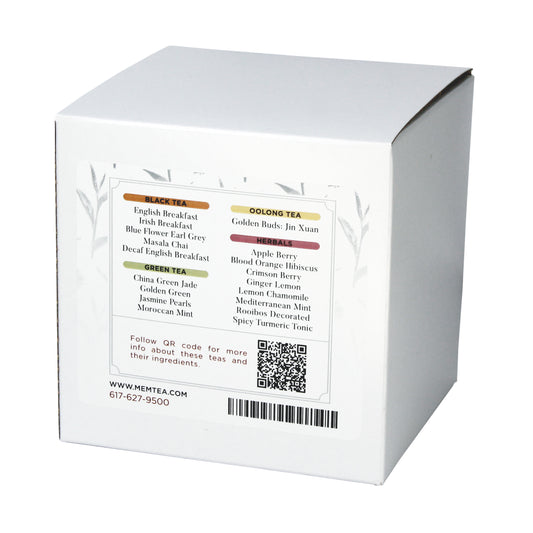Cherry Blossom

Tasting Notes:
sour cherry • pineapple • jasmine
Tart and luscious, like fresh cherry juice, this flavored sencha is bright and refreshing. The golden liquor is fragrant and floral, with notes of jasmine and rose blossoms. Makes for a unanimously enjoyed iced tea.
Ingredients: Camellia sinensis leaves, dried cherry, pineapple, papaya, raspberry, jasmine, rose petals, & natural flavoring. Caffeinated
Origin: China
FOR AN 8 OUNCE SERVING:
China Green Jade
Mao Jian

Tasting Notes:
alfalfa • collard greens • cashew
This mao jian (meaning "fur tips") boasts long, twisted, fuzzy emerald leaves that unfurl into a soft, buttery cup with a vegetal infusion. The golden liquor tastes of sweet sprouts and collard greens with a nutty finish. A stellar green tea.
Ingredients: Camellia sinensis leaves. Caffeinated
Origin: Hunan, China
FOR AN 8 OUNCE SERVING:
Clouds & Mist

Tasting Notes:
butterbean • white asparagus • cashew
Plucked in spring, from the high-elevation bushes grown in misty, cool cloud cover on Lu Mountain in Jiangxi, this famed tippy green tea is sweet, vegetal, and nutty. A premium brothy cup that's creamy and delightful.
Ingredients: Camellia sinensis leaves. Caffeinated
Origin: Jiangxi, China
FOR AN 8 OUNCE SERVING:
Dragonwell
Long Jing

Tasting Notes:
frisée • swiss chard • brazil nut
These legendary sword-shaped, pan-roasted, hand-folded leaves boast a brothy and vegetal cup with notes of steamed chard and bamboo shoots, finishing with a lingering nutty flavor. It's a beautiful tea in the cup and in the mouth.
Ingredients: Camellia sinensis leaves. Caffeinated
Origin: Zhejiang, China
FOR AN 8 OUNCE SERVING:
Golden Green

Tasting Notes:
sage • jasmine • lemon peel
Fruity, flowery, and herbaceous, this signature blend has it all and more - it's a complex, well-rounded, wildly flavorful beverage - a great intro to green tea. It also makes a refreshing iced tea that can be enjoyed year-round.
Ingredients: Camellia sinensis leaves, lemongrass, rooibos, orange peel, linden flowers, Mount olympus flowers, lavender, & orange flavor. Caffeinated
MEM Tea Signature Blend
FOR AN 8 OUNCE SERVING:
Gunpowder

Tasting Notes:
autumn leaves • smoke • cooked spinach
A classic green tea style from China dating back to the 7th century, these tightly rolled, pan-fired leaves yield an infusion with soft and vegetal notes and a lightly smoked finish. Great on its own but also perfect for blending.
Ingredients: Camellia sinensis leaves. Caffeinated
Origin: China
FOR AN 8 OUNCE SERVING:
Jasmine Flowering Buds

Tasting Notes:
gardenia • clover • honeydew
This hand-crafted jasmine tea bud blossoms into a precious bouquet of white flowers as the fresh spring leaves unfurl upon brewing. The flavor is sweet and delicate, with notes of gardenia and honeysuckle. A pleasure for all of the senses.
Ingredients: Camellia sinensis leaves & jasmine petals. Caffeinated
Origin: Fujian, China
FOR AN 8 OUNCE SERVING:
Jasmine Pearls

Tasting Notes:
magnolia • honeysuckle • bibb lettuce
A premium green tea that is arduously scented with blossoming jasmine flowers throughout several nights and then hand rolled into pearls, yielding an infusion with an undeniable jasmine flavor that is sweet and floral, with notes of honey.
Ingredients: Camellia sinensis leaves and jasmine scent. Caffeinated
Origin: Fujain, China
FOR AN 8 OUNCE SERVING:
Jasmine
Yin Hao

Tasting Notes:
endive • gardenia • squash blossom
With premium quality leaves scented with jasmine flowers, Yin Hao makes a fragrant, delicate cup with a jasmine aroma and vegetal flavors such as squash blossom and the mild bitterness of endive. This is a well-balanced and easily enjoyed green tea.
Ingredients: Camellia sinensis leaves and jasmine scent. Caffeinated
Origin: Fujian, China
FOR AN 8 OUNCE SERVING:
Moroccan Mint

Tasting Notes:
spinach • oregano • sweet mint
A blend of Chinese Gunpowder green tea and specially sourced mint leaves boasts a strong mint flavor accompanied by notes of spinach and oregano for a well-rounded but balanced and refreshing brew meant to mimic the popular iced tea of the same name.
Ingredients: Camellia sinensis leaves & mint leaves. Caffeinated
MEM Tea Signature Blend
FOR AN 8 OUNCE SERVING:
Peaflower Blossom

Tasting Notes:
jasmine • lemongrass • elderberry
Though it's blended with green tea, this is a brilliant blue/indigo infusion with strong floral and citrus notes. Pour it over ice and squeeze in some citrus to watch that blue magically turn into a refreshing deep-violet beverage.
Ingredients: Peaflowers, lemongrass, camellia sinensis leaves, jasmine petals, & elderberry. Caffeinated
MEM Tea Signature Blend
FOR AN 8 OUNCE SERVING:
Pine Needle Green

Tasting Notes:
kelp • alfalfa sprout • microgreen
Carefully shaped by hand to resemble pine needles and dried using traditional pine wood firing, the resulting tea is a brilliant golden brothy liquor with a light marine flavor and dense vegetal notes reminiscent of spring greens and alfalfa sprouts.
Ingredients: Camellia sinensis leaves. Caffeinated
Origin: Hunan, China
FOR AN 8 OUNCE SERVING:
Strawberries & Cream

Tasting Notes:
strawberry • oat • vanilla
When you fill your infuser with this much color, you know you're going to get something loaded with flavor. Sweet and creamy, this flavored green is fruity and decadent with vanilla undertones. Tea as dessert, yes please.
Ingredients: Camellia sinensis leaves, dried strawberries, pumpkin, carrot, rose petals, & natural flavoring. Caffeinated
Origin: China
FOR AN 8 OUNCE SERVING:
Genmai Cha

Tasting Notes:
steamed spinach • nori • popcorn
In the 15th century, blending rice with inexpensive Japanese green tea allowed laborers to maximize their minimal annual tea rations. Our elevated version of that recipe has a delicious popcorn flavor and vegetal notes, making it an easily accessible tea, even for new tea drinkers.
Ingredients: Camellia sinensis leaves and toasted & popped rice. Caffeinated
Origin: Shizuoka, Japan
FOR AN 8 OUNCE SERVING:
Gyokuro

Tasting Notes:
broth • edamame • collard greens
The deep-green, shade-grown, specially processed leaves of this Gyokuro ("jade dew") brew into a rich infusion with a brothy mouthfeel, savory vegetal flavors and umami, and a lingering, natural sweetness that will have you salivating.
Ingredients: Camellia sinensis leaves. Caffeinated
Origin: Shizuoka, Japan
FOR AN 8 OUNCE SERVING:
Kukicha

Tasting Notes:
asparagus • bean sprouts • barley
An entirely unique flavor—a blend of lightly roasted stems and leaves from early sencha production yields a twig tea or bōcha that is sweet and savory with vegetal and grainy flavors. Brew these leaves a few times, but with short steeps for a relaxing mindful moment.
Ingredients: Camellia sinensis leaves. Caffeinated
Origin: Shizuoka, Japan
FOR AN 8 OUNCE SERVING:
Sencha
Asamushi

Tasting Notes:
orange peel • spinach • bean sprout
This Asamushi, or 'light steamed sencha,' is bright and crisp. The golden green liquor has notes of citrus and fresh bean sprouts, with a green vegetal finish reminiscent of steamed spinach. It's a great everyday Japanese tea.
Ingredients: Camellia sinensis leaves. Caffeinated
Origin: Shizuoka, Japan
FOR AN 8 OUNCE SERVING:
Sencha
Fukamushi

Tasting Notes:
buttered zucchini • green bean • orange peel
At once buttery, vegetal, and fruity, this steamed tea is bright and sweet. It has a creamy mouthfeel and flavors of sweet beans, baby zucchini, and dried orange peel, with a tangy finish. It is a delightful addition to our sencha offerings.
Ingredients: Camellia sinensis leaves. Caffeinated
Origin: Shizuoka, Japan
FOR AN 8 OUNCE SERVING:
Sencha
Meiryoku

Tasting Notes:
cooked spinach • snap pea • edamame
Produced in Kagoshima from a single cultivar, this small-lot, deep steamed sencha brews to a vibrant green, crystal clear liquor that is light and creamy with a classic vegetal umami and slightly fruity profile. Get it while it lasts!
Ingredients: Camellia sinensis leaves. Caffeinated
Origin: Japan
FOR AN 8 OUNCE SERVING:
Sencha
Yamakai

Tasting Notes:
bok choy • sorrel • nori
Yamakai, meaning "mountain ravine," refers to a unique cultivar developed nearly a century ago. Too good to be blended with anything else, this sencha is bold and complex, with rich umami flavors. Think freshly foraged greens near the ocean.
Ingredients: Camellia sinensis leaves. Caffeinated
Origin: Japan
FOR AN 8 OUNCE SERVING:
Yuzu Matcha

Tasting Notes:
wheatgrass • lemon peel • mandarin orange
A blend of kukicha (Japanese twig tea) with yuzu chips and premium matcha powder makes this a more accessible matcha beverage that needs no whisking. Just steep in hot water and strain for a refreshing, fruity matcha treat.
Ingredients: Camellia sinensis leaves & yuzu peel. Caffeinated
Origin: Shizuoka, Japan
FOR AN 8 OUNCE SERVING:
Matcha: Aoarashi
(Marukyu Koyamaen)

Tasting Notes:
baby spinach • cucumber • split pea
Light and smooth, this Ceremonial Grade Matcha is easy to drink. Sweet flavors of fresh baby spinach and cucumber are finished with the creamy texture of split pea soup.
We source our matcha from Marukyu Koyamaen, a highly regarded tea grower, procurer, and tea blender whose private tea estate, located in the heart of Uji, Kyoto, has a rich history dating back to 1704. Koyamaen has strict quality control systems in place that target a wide variety of issues that can affect the quality, taste, and characteristics of their tea: Teas are kept fresh using a unique drying system that reduces moisture in the leaf to an incredibly low level which is verified by an infrared optical moisture meter. Since a vibrant color is essential to the matcha experience, a colorimeter is utilized to ensure that the matcha has a naturally vibrant hue. Finally, the particle size of the matcha is strictly controlled which ensures each particle is fine enough to deliver an easy-to-blend, smooth-tasting beverage.
Ingredients: Camellia sinensis leaves. Caffeinated
Origin: Uji, Japan
PREPARATION:
Sift 2 to 3 grams of powder into a bowl and whisk with 2 to 4 oz of 175°F water until frothy.
40 g Tin
Matcha: Gabaron
(Marukyu Koyamaen)

Tasting Notes:
nori • wheat grass • unsweetened cocoa
This Ceremonial Grade Matcha is soft and smooth with deep vegetal notes of nori and wheat grass with a bittersweet finish reminiscent of unsweetened cocoa. Special processing gives it an additional boost of GABA, the neuro - inhibitor of stress and anxiety.
We source our matcha from Marukyu Koyamaen, a highly regarded tea grower, procurer, and tea blender whose private tea estate, located in the heart of Uji, Kyoto, has a rich history dating back to 1704. Koyamaen has strict quality control systems in place that target a wide variety of issues that can affect the quality, taste, and characteristics of their tea: Teas are kept fresh using a unique drying system that reduces moisture in the leaf to an incredibly low level which is verified by an infrared optical moisture meter. Since a vibrant color is essential to the matcha experience, a colorimeter is utilized to ensure that the matcha has a naturally vibrant hue. Finally, the particle size of the matcha is strictly controlled which ensures each particle is fine enough to deliver an easy-to-blend, smooth-tasting beverage.
Ingredients: Camellia sinensis leaves. Caffeinated
Origin: Uji, Japan
PREPARATION:
Sift 2 to 3 grams of powder into a bowl and whisk with 2 to 4 oz of 175°F water until frothy.
40 g Tin
Matcha: Isuzu
(Marukyu Koyamaen)

Tasting Notes:
fresh grass • citrus • spring greens
This ceremonial grade Matcha is bright and creamy with notes of fresh grass, citrus and sweet spring greens. Whisked in the traditional style, this Matcha is soft and round with a bright vegetal finish. An invigorating start to your daily routine.
We source our matcha from Marukyu Koyamaen, a highly regarded tea grower, procurer, and tea blender whose private tea estate, located in the heart of Uji, Kyoto, has a rich history dating back to 1704. Koyamaen has strict quality control systems in place that target a wide variety of issues that can affect the quality, taste, and characteristics of their tea: Teas are kept fresh using a unique drying system that reduces moisture in the leaf to an incredibly low level which is verified by an infrared optical moisture meter. Since a vibrant color is essential to the matcha experience, a colorimeter is utilized to ensure that the matcha has a naturally vibrant hue. Finally, the particle size of the matcha is strictly controlled which ensures each particle is fine enough to deliver an easy-to-blend, smooth-tasting beverage.
Ingredients: Camellia sinensis leaves. Caffeinated
Origin: Uji, Japan
PREPARATION:
Sift 2 to 3 grams of powder into a bowl and whisk with 2 to 4 oz of 175°F water until frothy.
40 g Tin
Matcha: Kinrin
(Marukyu Koyamaen)

Tasting Notes:
sea foam • buttered spinach • sweet pea
This tea is our highest grade of ceremonial matcha. Whisked in the traditional style, this matcha becomes light and fluffy, with a soft sweet finish of buttered spinach and sweet peas. The sweetness lingers on the palate well after the completion of your ritual.
We source our matcha from Marukyu Koyamaen, a highly regarded tea grower, procurer, and tea blender whose private tea estate, located in the heart of Uji, Kyoto, has a rich history dating back to 1704. Koyamaen has strict quality control systems in place that target a wide variety of issues that can affect the quality, taste, and characteristics of their tea: Teas are kept fresh using a unique drying system that reduces moisture in the leaf to an incredibly low level which is verified by an infrared optical moisture meter. Since a vibrant color is essential to the matcha experience, a colorimeter is utilized to ensure that the matcha has a naturally vibrant hue. Finally, the particle size of the matcha is strictly controlled which ensures each particle is fine enough to deliver an easy-to-blend, smooth-tasting beverage.
Ingredients: Camellia sinensis leaves. Caffeinated
Origin: Uji, Japan
PREPARATION:
Sift 2 to 3 grams of powder into a bowl and whisk with 2 to 4 oz of 175°F water until frothy.
20 g Tin
Matcha: Yugen
(Marukyu Koyamaen)

Tasting Notes:
broccoli • asparagus • white bean
Rich and creamy, this ceremonial grade matcha boasts deep vegetal flavors of steamed broccoli and asparagus rounded out with the silken texture of cooked white beans. A complex experience.
We source our matcha from Marukyu Koyamaen, a highly regarded tea grower, procurer, and tea blender whose private tea estate, located in the heart of Uji, Kyoto, has a rich history dating back to 1704. Koyamaen has strict quality control systems in place that target a wide variety of issues that can affect the quality, taste, and characteristics of their tea: Teas are kept fresh using a unique drying system that reduces moisture in the leaf to an incredibly low level which is verified by an infrared optical moisture meter. Since a vibrant color is essential to the matcha experience, a colorimeter is utilized to ensure that the matcha has a naturally vibrant hue. Finally, the particle size of the matcha is strictly controlled which ensures each particle is fine enough to deliver an easy-to-blend, smooth-tasting beverage.
Ingredients: Camellia sinensis leaves. Caffeinated
Origin: Uji, Japan
PREPARATION:
Sift 2 to 3 grams of powder into a bowl and whisk with 2 to 4 oz of 175°F water until frothy.
40 g Tin
Matcha: Premium
(Marukyu Koyamaen - Byakuren)

Tasting Notes:
soft • grassy • vegetal
Made from a premium grade Japanese green tea powder, this Matcha is soft and smooth with deep grassy and vegetal notes. This Matcha is assertive enough for lattes but smooth enough to drink on its own. Makes a great tasting beverage with or without milk.
We source our matcha from Marukyu Koyamaen, a highly regarded tea grower, procurer, and tea blender whose private tea estate, located in the heart of Uji, Kyoto, has a rich history dating back to 1704. Koyamaen has strict quality control systems in place that target a wide variety of issues that can affect the quality, taste, and characteristics of their tea: Teas are kept fresh using a unique drying system that reduces moisture in the leaf to an incredibly low level which is verified by an infrared optical moisture meter. Since a vibrant color is essential to the matcha experience, a colorimeter is utilized to ensure that the matcha has a naturally vibrant hue. Finally, the particle size of the matcha is strictly controlled which ensures each particle is fine enough to deliver an easy-to-blend, smooth-tasting beverage.
Ingredients: Camellia sinensis leaves. Caffeinated
Origin: Kyoto, Japan
PREPARATION:
Sift 2 to 3 grams of powder into a bowl and whisk with 2 to 4 oz of 175°F water until frothy.
Matcha
(Marukyu Koyamaen - Suisen)

Tasting Notes:
bright • grassy • bitter greens
This Culinary grade Japanese green tea powder is bright and grassy with a pleasant astringency that shines through a variety of sweeteners and dairy products. Great for lattes, baked goods and ice cream production, this Matcha is versatile and great for everyday use.
We source our matcha from Marukyu Koyamaen, a highly regarded tea grower, procurer, and tea blender whose private tea estate, located in the heart of Uji, Kyoto, has a rich history dating back to 1704. Koyamaen has strict quality control systems in place that target a wide variety of issues that can affect the quality, taste, and characteristics of their tea: Teas are kept fresh using a unique drying system that reduces moisture in the leaf to an incredibly low level which is verified by an infrared optical moisture meter. Since a vibrant color is essential to the matcha experience, a colorimeter is utilized to ensure that the matcha has a naturally vibrant hue. Finally, the particle size of the matcha is strictly controlled which ensures each particle is fine enough to deliver an easy-to-blend, smooth-tasting beverage.
Ingredients: Camellia sinensis leaves. Caffeinated
Origin: Kyoto, Japan
PREPARATION:
Sift 2 to 3 grams of powder into a bowl and whisk with 2 to 4 oz of 175°F water until frothy.
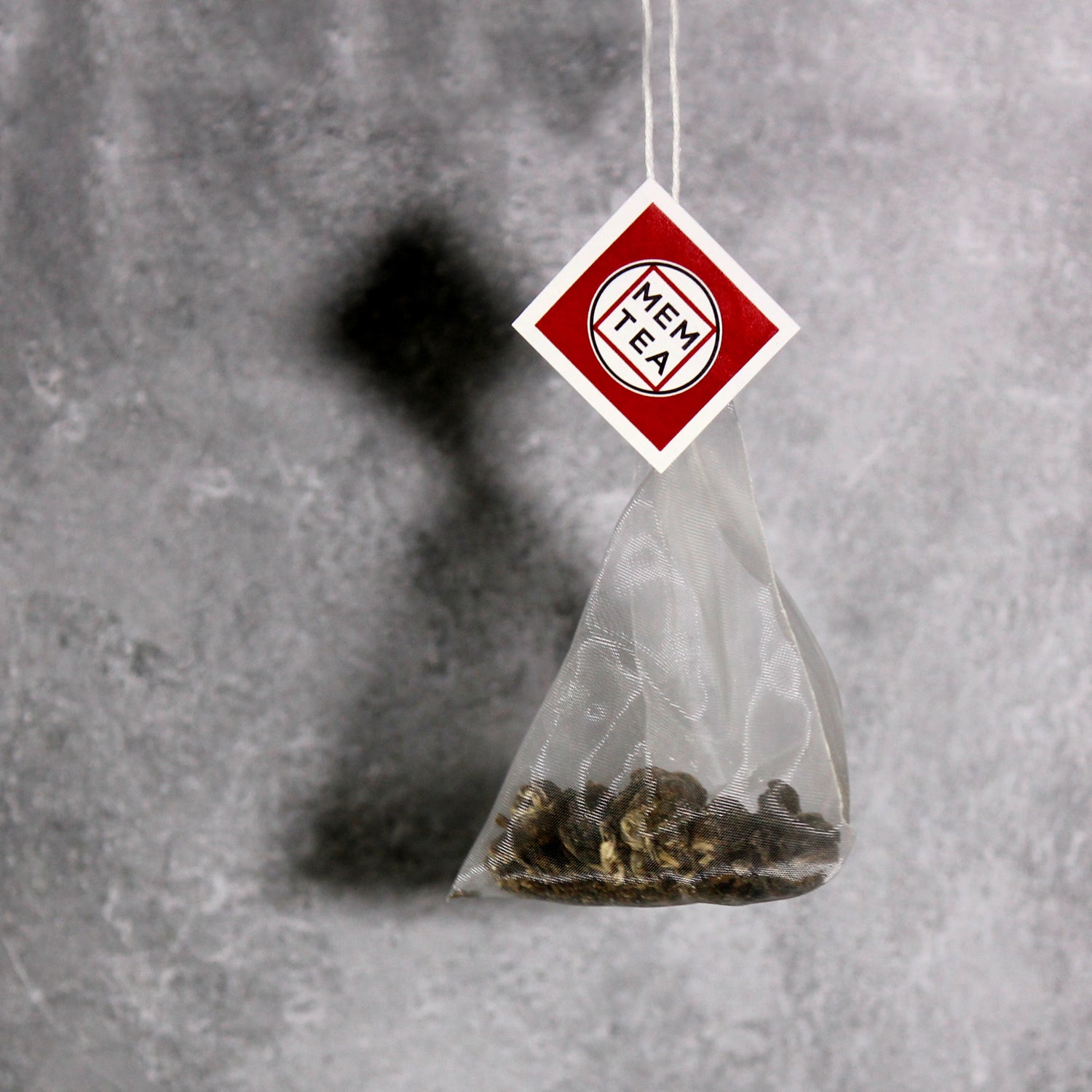
GREEN PYRAMID TEA BAGS
Our teabags, or ‘pyramids’ contain the same high quality loose leaf tea and blends that we sell as whole leaf orthodox tea. The teas are blended in our warehouse in Wakefield, MA and sent to a facility that packages them into pyramids. The pyramids are roomy enough to allow the tea to unfurl and steep properly. Our tea bags are composed of Soilon which is a Polylactic acid (PLA)-based material that is biodegradable, and the seams are heat-sealed rather than sealed with plastic in order to maintain the integrity and safety of their makeup.
IDEAL TEAWARE FOR GREEN TEA
Green tea is a very diverse category, especially when it comes to leaf shape. Broader leaf teas are great for gong fu style brewing (gaiwans and small clay teapots) while smaller leaf and blended greens would prefer western style teapots that have fine mesh infusers and strainers.
HARIO
Glass Teapot
If you're a tea hound, guzzling delicious warmth all day long, then this Japanese borosilicate-glass teapot is meant for you! It also pours well for larger tea parties, AND since it's big and clear, it's a perfect vessel to show off those high-quality leaves that you love to share.
This big boy is comfortable in the hand, making it easy to grip and pour - plus, it's very easy to clean.
The large fine mesh infuser basket is perfect for teas with any leaf size or those that contain small ingredients, such as spices.
GLASS TEAPOT & LID: HANDWASH ONLY
STRAINER: DISHWASHER SAFE
TEAPOT SIZE: 7" X 5.5" X 4.5" tall
STRAINER SIZE: 3.75" diameter X 2.5" deep
VOLUME: 24 oz (700 ml)
Strainer holds approximately 8 scoops of tea
with plenty of room for leaves to unfurl
$25.00
Somerville Flip Lid Teapot
As you inevitably forget you have hot-brewed tea, which happens to the best of us, the thick walls of glazed ceramic on this classic Western-style teapot will keep it steaming hot.
The deep metal infuser slips right into the teapot, providing ample room for high-quality tea leaves to unfurl and release their flavor.
Keep this one on your desk during the workday, and you'll be rewarded with hot tea (and a hand warmer) through all the distractions of the day job - one delicious brew in the morning and one in the afternoon.
CERAMIC TEAPOT: HANDWASH ONLY
STRAINER: DISHWASHER SAFE
TEAPOT SIZE: 7" X 4.75" X 4" tall
STRAINER SIZE: 2.75" diameter X 2.5" tall
VOLUME: 16 oz (475 ml)
Strainer holds approximately 6 scoops of tea
with plenty of room for leaves to unfurl
$32.00
Bamboo Tea Rake
Add this unexpectadly useful tool to your collection - it can be utilized in a number of ways: pushing tea from a bamboo scoop into a teapot, inspecting ingredients, picking pesky wet tea leaves out of strainers to avoid sensory issues, and any number of other tasks that may arrise in the preparation and consumption of tea.
HANDWASH ONLY
SIZE: 7" long
$9.50
Black & Gold Tea Strainer
This super fine mesh infuser, with a lid/dish, has a narrow base which, when inserted into a mug, allows enough depth and space for the perfect steep.
DISHWASHER SAFE
SIZE: 4" X 3" X 3.5" tall
Holds approximately 7 scoops of tea
with plenty of room for leaves to unfurl
$13.00
FORLIFE
Brew-In-Mug Infuser
with Lid
This large stainless steel in-mug infuser from FORLIFE features tiny 0.3 mm holes and a large silicone rimmed lid which doubles as a coaster. When inserted into a mug this infuser has enough depth and space to brew a perfect mug. Available in black, white, turquoise, or red.
DISHWASHER SAFE
SIZE: 4.5" X 3.75" X 3.25" tall
Holds approximately 8 scoops of tea
with plenty of room for leaves to unfurl
$24.00
FORLIFE
Tea Strainer
with Dish Set
This large stainless steel in-mug infuser from FORLIFE features tiny 0.3 mm holes and a white ceramic basket rest for holding the strainer between steeps.
HANDWASH ONLY
SIZE: 5.5" X 3" X 2.5" tall
Holds approximately 6 scoops of tea
with plenty of room for leaves to unfurl
$17.95
FORLIFE
Lucidity Brew-In-Cup Infuser
The large stainless-steel infuser from FORLIFE features tiny 0.3 mm holes and has a lid which doubles as a coaster, fits snugly into the 12-ounce borosilicate glass mug.
STRAINER & LID: DISHWASHER SAFE
GLASS CUP: HANDWASH ONLY
GLASS MUG SIZE: 4.5" X 3.5" X 3.5" tall
STRAINER SIZE: 4.25" X 3.25" X 3" deep
VOLUME: 12 oz (355 ml)
Strainer holds approximately 6 scoops of tea
with plenty of room for leaves to unfurl
$26.00
Cold Brew Bottle
This space saving cold brew tea infuser doubles as a handsome decanter that will complement any table setting. Cold brewed tea can be accomplished in your refrigerator overnight. The result is complex and flavorful without any astringency.
HANDWASH ONLY
SIZE: 3.25" diameter X 12" tall
VOLUME: 25 oz (740 ml)
$30.00
Perfect Tea Scoop
Whether you're perfecting your gong fu cha practice, filling the brew basket of a western style teapot, or traveling with your tea, this easy-to-clean, stainless-steel teaspoon will help you measure out perfect consistent scoops, every time, every day. We keep one in our backpack, just in case.
DISHWASHER SAFE
SIZE: 5" X 1.2"
VOLUME: 1 teaspoon
$6.00
IDEAL TEAWARE FOR JAPANESE GREEN TEA
Being that Japanese Green Tea is a whole category of its own, it warrants its own line of teaware, specifically designed to showcase the beauty of its leaf and its flavors. Japanese side-handle teapots (kyusus) are constructed with super fine, built in mesh strainers. These are perfect for the finely folded leaves of Japanese green tea.
Small White Kyusu
Side Handle Teapot
This delightful tiny side handled teapot is made of glazed porcelain of the faintest robin's egg blue hue, it's almost white. The interior has a full circumference mesh strainer lining for a clean cup of fine Japanese green tea.
HANDWASH ONLY
SIZE: 4.5" X 3.75" X 2" tall
VOLUME: 1 oz (30 ml)
$20.00 $16.00
WAS:
*discount automatically applied at checkout
Taupe Petals Kyusu
Side Handle Teapot
Bright and sunny, this kyusu is comfortable in size and cheerful in color. The simple flower pattern complements any decor while lightening your mood.
HANDWASH ONLY
SIZE: 6.5" X 5.5" X 3.5" tall
VOLUME: 8 oz (237 ml)
$55.00 $44.00
WAS:
*discount automatically applied at checkout
Bubble Sharing Pitcher
This borosilicate glass sharing pitcher is double walled for ease of handling and heat retention. Its unique shape artfully blends the flavor and aromatics of multiple steeps while displaying the liquor in an elegant fashion.
HANDWASH ONLY
SIZE: 4" X 3.5" X 3.75" tall
VOLUME: 7 ounce (207 ml)
$19.50
Bamboo Tea Rake
Add this unexpectadly useful tool to your collection - it can be utilized in a number of ways: pushing tea from a bamboo scoop into a teapot, inspecting ingredients, picking pesky wet tea leaves out of strainers to avoid sensory issues, and any number of other tasks that may arrise in the preparation and consumption of tea.
HANDWASH ONLY
SIZE: 7" long
$9.50
Perfect Tea Scoop
Whether you're perfecting your gong fu cha practice, filling the brew basket of a western style teapot, or traveling with your tea, this easy-to-clean, stainless-steel teaspoon will help you measure out perfect consistent scoops, every time, every day. We keep one in our backpack, just in case.
DISHWASHER SAFE
SIZE: 5" X 1.2"
VOLUME: 1 teaspoon
$6.00
Sakura Tea Cups
set of 2
A festive addition to any tea collection. These cups make sharing easy and fun. They are a great addition to any teapot, or a great way to turn the Sakura tea set into a party.
HANDWASH ONLY
SIZE: 3" diameter X 3.25" tall ea.
VOLUME: 6 oz (177 ml) ea.
$12.00
Blue Lotus Gong Fu Tea Cups
set of 2
These little gems are dainty companions to the Blue Lotus Teapot. The intricate lotus design and the sunburst pattern illuminate the liquor while retaining fragrance. A truly sensual experience.
HANDWASH ONLY
SIZE: 2.25" diameter X 2" tall ea.
VOLUME: 1 oz (30 ml) ea.
$18.50
Sandstone Matcha Set
Included in the 4 piece set is a ceramic 16 oz bowl (chawan), a bamboo whisk (chasen) whisk holder (naoshi) and bamboo tea scoop (chashaku) - all the essential tools needed for matcha latte preparation or your very own tea ceremony. The earthy sandstone bowl and whisk holder are attractive additions to any tea collection.
HANDWASH ONLY
BOWL SIZE: 5" X 5" X 3" tall
BOWL VOLUME: 16 oz (473 ml)
$57.50
ABOUT GREEN TEA
Green tea is where it all started! With over 1,000 years of history, this is the world’s first form of Camellia sinensis leaves brewed in water. Tea farmers have created hundreds of green tea styles in that time, refining their techniques over the centuries. These crisp and delicate brews remain the most popular teas in China and Japan.
Such longevity and diversity means that green tea flavors can range from bright and grassy to soft and buttery. Some styles feature a delicate liquor while others are rich and brothy. These brews are generally known for a distinctive vegetal character that’s as close as you can get to the taste of a fresh leaf plucked off a tea plant. Since they’re processed before the leaves can oxidize, green teas are especially high in antioxidants and polyphenols. Steep these traditional handmade teas for a grounding moment of calm.
ABOUT JAPANESE GREEN TEA
Japanese green tea is a category all its own. Unlike most green styles, these teas are steamed during processing to coax fresh marine flavors from the leaf. They have a unique umami note and a balanced brothy character.
Sencha is Japan’s most popular green tea, made from high quality early spring leaves. Affordable, easy drinking banchas like hojicha and genmaicha are made with more mature leaves later in the season, and premium green teas like matcha and gyokuro are shaded before harvest to increase their sweetness and umami. Which one will be your favorite? You may just have to try them all.
ABOUT MATCHA
We are the United State's largest distributor of matcha from award-winning Marukyu Koyamaen, a highly regarded tea grower, procurer, and tea blender whose private tea estate, located in the heart of Uji, Kyoto, has a rich history dating back to 1704.
Koyamaen has strict quality control systems in place that target a wide variety of issues that can affect the quality, taste, and characteristics of their tea: Teas are kept fresh using a unique drying system that reduces moisture in the leaf to an incredibly low level which is verified by an infrared optical moisture meter. Since a vibrant color is essential to the matcha experience, a colorimeter is utilized to ensure that the matcha has a naturally vibrant hue. Finally, the particle size of the matcha is strictly controlled which ensures each particle is fine enough to deliver an easy-to-blend, smooth-tasting beverage.

MEM TEA Online Gift Card






















































